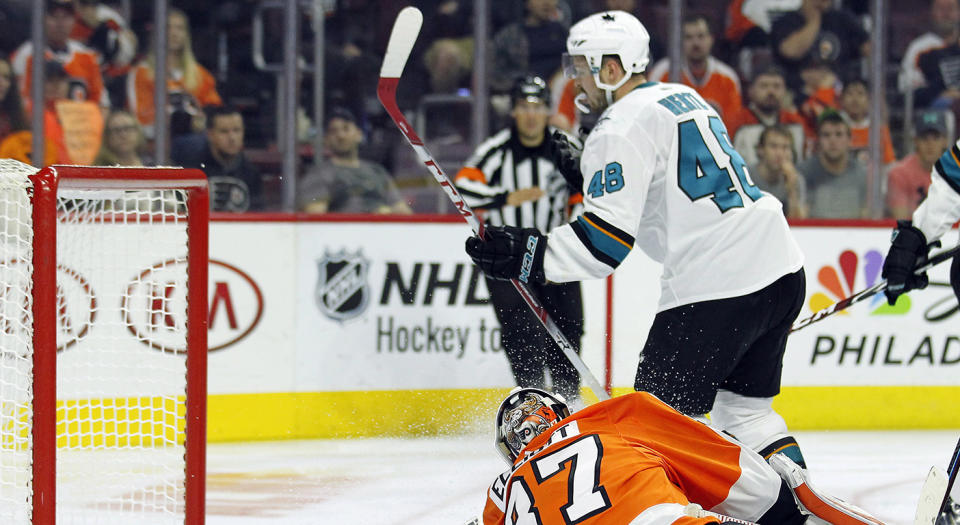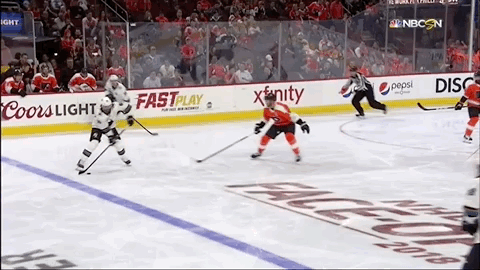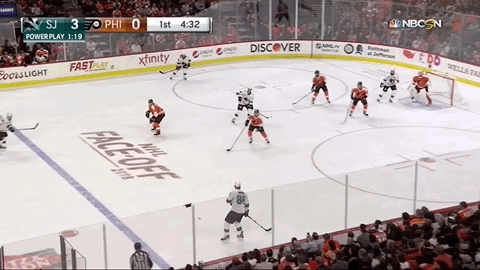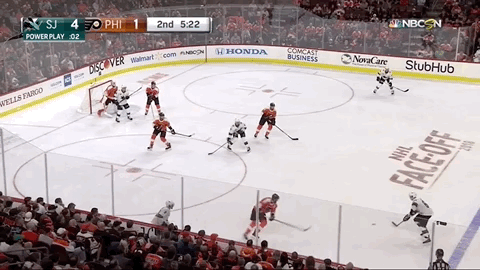Sharks give first demonstration of just how scary they can be

The San Jose Sharks were projected to be one of this season’s NHL’s heavyweights, but in their first three games they didn’t exactly live up to billing.
On either side of a hard-fought overtime win over the Los Angeles Kings, the Sharks fell 5-2 to the Anaheim Ducks and were shut out 4-0 by the New York Islanders. Not exactly a cause for panic, but not what you’d expect from an already-excellent team that added Erik Karlsson.
The goal numbers alone were misleading, though. In Game 1 San Jose outshot its opponent 33-14, in Game 2 that was 33-21 and in Game 3 the tally lay at a less lopsided, but still solid, 35-29. The Sharks started the season exactly the way they planned, flying around the ice and controlling the play. The pucks just hadn’t gone in for them, and Martin Jones had been on the leaky side.
San Jose wasn’t a club limping out of the gate coming into Tuesday’s action, it was a team waiting to explode — and explode it did to the tune of an 8-2 win over the Philadelphia Flyers. The Sharks didn’t just get a needed win, they put on the kind of show that should put the whole league on notice.
Despite the fact they’re 2-2, the Sharks may be the best team in hockey, and we should soon be seeing improvement from them in every facet of the game:
1. 5-on-5 Domination
So far, the Sharks are the best possession team in hockey, and only the surprising Carolina Hurricanes have been close. At 5-on-5 they have out-attempted their opponents by an outrageous 229-130 margin. Somehow they’ve only outscored their opponents 8-6 over that time.
If they continue to carry the play like this, there’s no way the Sharks don’t widen that goal differential and begin cruising to more victories. Special teams certainly win games, but over the course of a season there’s no indicator as reliable as 5-on-5 success.
The Sharks might not ride a 60-plus Corsi percentage all season, but with the addition of Karlsson, they have one of the best men at moving and transitioning the puck in the game. You add that to a team that was already in the top half of the league last year and you’re going to spend an awful lot of time in your opponent’s zone. A full season of Evander Kane certainly doesn’t hurt either.
2. A Possibly-Ridiculous Power Play
The Sharks’ power play hasn’t really gotten going yet, but to doubt it is to doubt some of the league’s best talents. With Karlsson and Burns in tow it’s hard to imagine this group not thriving.
It’s usual to have two defencemen on a power-play unit these days, especially two defencemen who shoot from the right side, but Karlsson and Burns are so special that the Sharks have no choice but to try it. Coming into Wednesday’s action it hadn’t paid dividends, as the club had yet to score with the man advantage, but that changed in the third period when the two combined on their first goal together — ultimately banged in by Tomas Hertl.

The goal gives a hint at how the two can co-exist. Having them both set up at the points would make the unit too static and prevent enough players from getting to the net. Instead, it looks like Burns is going to live on the half wall at times, acting more like a winger and Karlsson can be a little more like a traditional point man.
That doesn’t mean anything is set in stone. Earlier in the game, Logan Couture was the fulcrum between Burns and Karlsson as the dangerous Swede almost got his first goal as a Shark from an Ovechkin-like position.

A fluid and versatile grouping like this, which also includes a 30-goal man in Logan Couture and a net-front beast in Joe Pavelski, is destined to do far better than the 13.3 percent we’ve seen so far.
Even the team’s second unit has solid potential as the steady Marc-Edouard Vlasic quarterbacks a group focussed around Kane’s sniping. The 31-year-old rearguard set up the dangerous winger just as a power play was ending in the second that should be rather typical of what this grouping will try to do.

Considering Kane also added another with this group on a close-quarters scramble in the drudging of the Flyers, it was a banner day for the PP2.
Things look promising now, and the power-play prospects only get better for the Sharks when Jumbo Joe returns.
3. A Bounce-Back Penalty Kill
Arguably the reason the Sharks are just 2-2 so far is their penalty kill. They haven’t helped themselves by leading the NHL with 18 minor penalties taken, but they also haven’t done a good job killing those penalties at a 72.2 percent clip.
The good news for San Jose is that there’s no reason to believe this trend will continue. Last season they killed penalties at a rate of 84.8 percent — second only to the Los Angeles Kings. There hasn’t been nearly enough turnover on this club to assume that success can’t be approached, if not replicated.
Digging a little deeper into the numbers, the Sharks have allowed a Corsi/60 against of 104.56 when short-handed, which is more bad than disastrous. That mark ranks 21st in the league and it means they’re allowing just over three shot attempts per penalty kill. Again, not ideal, but nothing that would indicate this unit is falling apart.
Could it use some tweaks? Sure. But the strength of Peter DeBoer’s group last year makes it seem likely there’s a bounce back here.
On the plus side for the Sharks they are also the only team with multiple short-handed goals, including a beauty from Barclay Goodrow on Tuesday.

4. Rock-Solid Goaltending
So far the Sharks have not gotten top-notch work between the pipes. The Jones-Aaron Dell tandem has combined for an ugly .887 save percentage that’s been an enormous factor in their two early losses.
Although too much ink has been spilled about the unpredictability of goaltenders, this pair is about as much of a known quantity as you can possibly have. Last season they combined for a .914 save percentage, narrowly above the league average of .912. The year before it was .916.
Jones has a career SV% of .915 and Dell’s is .921 in a much smaller sample. These guys are not elite, but they are consistent and reliable. This is the third year the Sharks are rolling out this tandem and as both goalies are 29, there’s no reason to expect a decline.
It’s very unlikely that the Vezina Trophy will make its home in San Jose this year, but there’s no reason to worry about this part of the club. On Tuesday, they got their first really strong start of the year as Dell saved 31 of 33 shots. They won’t get that type of performance every night, but they won’t need it. Solid is all they need, and solid is what they’ve got.
More NHL coverage from Yahoo Canada Sports

 Yahoo Sports
Yahoo Sports 
